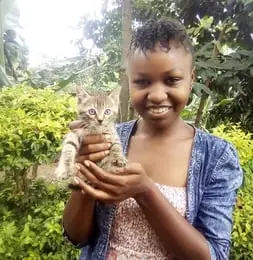
The frequency at which a cat purr is
Cats purr with a consistent pattern and frequency between 20 and 150 Hertz.
As the muscles on your cat’s larynx move, they constrict the vocal cords, resulting in air vibrations called purrs. The frequency of these vibrations is said to promote bone growth.
Cats purr when they are nursing their kittens, or when a human stroke or feeds it. Your cat will also purr when about to sleep, dying, grooming each other, or investigating a new environment.
Cats Purr Explained
Our feline friends communicate with us in various ways, but one particularly interesting sound they make is the purr. It is often associated with contentment and happiness or as an expression of pleasure.
You must be curious to know how your cat manages to make this sound, the frequency, and if there are any benefits to you or your cat.
I will tell you all about your cat’s purring frequency. Don’t be too scared if this topic sounds too technical, I will explain this in simple terms.
The exact frequency depends on its circumstances
The frequency of a cat’s purr varies depending on circumstances. It might purr loudly when you stroke it in places it likes, such as the chin. This shows it is happy. But sometimes your cat will purr even when you are not around.
People who own more than one cat point out that no two cats are the same. Some cats will purr loudly, and others will rarely purr.
The frequency of your cat’s vibrations range from 20Hz to 150Hz, during both inhalation and exhalation. As your cat breathes, the air touches the vibrating muscles, and this is what produces the purring sound.
This has been thought to promote bone growth. According to researchers, your cat’s purring frequencies “correspond with established healing frequencies therapeutic medicine for humans.”
Since cats spend long hours sleeping, purring helps stimulate their bones to prevent it from becoming too brittle or weak.
Thus, you might assume your cat’s purring in its slumber is a sign of contentment, but it could be a form of self-repair. The vibrations are a way to keep its bones and tissue in good condition as it is resting.
Some cats have a high-pitched purr, while others will just purr in a low rumble. It is just a matter of cat personality.
Your Cat’s Purr Has a Healing Effect
Our furry friends always seem to have a way to brighten up our days. The purring sound may indicate that our kitty is looking for attention, hungry, or just content. But these rumbles may also have an added health benefit to the humans surrounding us.
The purr vibrations your cat creates have been found to be medically therapeutic in these various ways:
1. Lowers stress

As you pet your purring cat, it helps to calm down your nerves. This is vital to lower stress levels, and this will significantly reduce your risk of cardiovascular diseases. A study showed that people who own cats have 40% less risk of heart attack.
Just watching funny cat videos on the internet can boost your energy level and incite positive emotions.
The next time you feel stressed, just pet your feline companion and experience the calming effect. The frequencies of your purring cat can make you feel more at ease. It is what you need to make you and your cat happy.
2. Lowers blood pressure
As you interact with your cat and you hear the purring sound, this helps lower blood pressure. Its companionship as your cat naps beside you provides you with pleasure and delight, and this has a calming effect on you.
Purrs release feel-good hormones called endorphins.
3. You sleep better
Do you like to snuggle with your cat as you sleep? You might be surprised to know about the benefit that comes with it. According to a study by Mayo Clinic, 41% of people said they sleep better because of their pet.
4. Healing of muscles and ligament injuries
Frequencies of 25 and 50 Hz are the best for promoting bone strength. Scientists have concluded that whole-body vibrations of 35 to 50Hz are helpful to stimulate bone healing and for healing soft tissue, ligament injuries, and muscle.
They are also useful in healing infection and swelling.
How to Tell the Reason Behind a Cat’s Purr
Purring is often an indication of happiness. If you are not sure, just check your cat’s body language. If it looks relaxed, eyes half-closed and lying on its back, then your pet friend so happy. The noise it is making is a feline smile.
However, occasionally your cat might purr to remind you that its mealtime. The purr your cat makes when it is happy and relaxed does not sound the same with the purr it makes when it is hungry.
When your cat purrs for food, it combines the purr with an unpleasant meow, something similar to a baby’s cry. One study found that when cats purred to get their owners to feed them, the frequency shot up to 220 Hz. This is why experts believe that cat owners are more likely to respond to this sound.
This purr is sometimes referred to as solicitation purr. Interestingly, even non-cat owners can tell the difference between these two purrs.
Purring is also a self-comforting behavior. Kittens start purring to their mother when they are only a few days old, an indication to the mother that it is time to feed her kittens. Her kitties can feel their mother’s purr’s vibrations. This habit continues into their adult lives.
Always check out your cat’s body language. If it swipes with its paws, it’s probably pissed off even if it is purring.
Other signs accompanied by purring to show your cat is happy are:
- Kneading: Whether you call it playing piano or free massage, this common behavior pattern in cats is normally accompanied by purring. Kneading gives your cat the feeling of comfort, such as when it is nursing. It is a happy sign to show your cat feels safe.
- Tail up: If your cat purrs as it holds its tail high up and the tip of its tail is twitching, it means your cat is in a good mood and exceptionally pleased to see you.
- Slow blink: Feline creatures will only close their eyes in the presence of another creature if they trust them. As your cat purrs and blinks slowly at you, know that it trusts you.
- Rubbing or head bunting: Cats have scent glands located on their chin, cheeks and head that it uses to mark objects and people. As your cat rubs itself against your leg, it is using these glands to mark you as its own. It’s also a sign that your cat feels safe in its surroundings.
It Is normal for a Cat to Purr Loudly

It is quite normal for a cat to purr loudly. Your cat might be the one that purrs loudly while other cats will just rumble slowly. You will notice that your cat purrs loudly when you are doing things that it enjoys, such as rubbing its chin.
Loud purrs are common if the cat is a former stray, and you have kept it warm and well-fed. It might be a way of telling you it feels safe in its new environment. It’s a good thing because this is how cats communicate their pleasure.
So, don’t be worried if your cat doesn’t purr. Each cat purrs at a different volume.

https://www.bbc.com/future/article/20180724-the-complicated-truth-about-a-cats-purr
https://www.mentalfloss.com/article/63725/healing-power-cat-purr
https://www.mayoclinicproceedings.org/article/S0025-6196(15)00674-6/fulltext